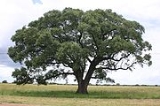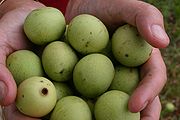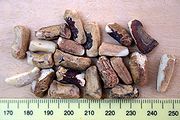
Sclerocarya birrea
Encyclopedia



Greek language
Greek is an independent branch of the Indo-European family of languages. Native to the southern Balkans, it has the longest documented history of any Indo-European language, spanning 34 centuries of written records. Its writing system has been the Greek alphabet for the majority of its history;...
σκληρός, sklērós, "hard", and κάρυον, káryon, "nut", in reference to the stone inside the fleshy fruit) is a medium-sized dioecious
Dioecious
Dioecy is the property of a group of biological organisms that have males and females, but not members that have organs of both sexes at the same time. I.e., those whose individual members can usually produce only one type of gamete; each individual organism is thus distinctly female or male...
tree, indigenous to the miombo
Miombo
Miombo is the Swahili word for Brachystegia, a genus of tree comprising a large number of species. Miombo woodland is classified in the tropical and subtropical grasslands, savannas, and shrublands biome...
woodlands of Southern Africa
Africa
Africa is the world's second largest and second most populous continent, after Asia. At about 30.2 million km² including adjacent islands, it covers 6% of the Earth's total surface area and 20.4% of the total land area...
and the Sudano-Sahelian range of West Africa. The tree is a single stemmed tree with a wide spreading crown. It is characterised by a grey mottled bark. The tree grows up to 18m tall mostly in low altitudes and open woodlands. The fruit
Fruit
In broad terms, a fruit is a structure of a plant that contains its seeds.The term has different meanings dependent on context. In non-technical usage, such as food preparation, fruit normally means the fleshy seed-associated structures of certain plants that are sweet and edible in the raw state,...
s are used in the liqueur
Liqueur
A liqueur is an alcoholic beverage that has been flavored with fruit, herbs, nuts, spices, flowers, or cream and bottled with added sugar. Liqueurs are typically quite sweet; they are usually not aged for long but may have resting periods during their production to allow flavors to marry.The...
Amarula
Amarula
Amarula is a cream liqueur manufactured in South Africa. It is made with sugar, cream and the fruit of the African Marula tree which is also locally called the Elephant tree or the Marriage Tree. It has an alcohol content of 17% by volume...
. The distribution of this species throughout Africa has followed the Bantu in their migrations, as it has been an important item in their diet since time immemorial.
When ripe, the fruits have a light yellow skin, with white flesh, rich in vitamin C
Vitamin C
Vitamin C or L-ascorbic acid or L-ascorbate is an essential nutrient for humans and certain other animal species. In living organisms ascorbate acts as an antioxidant by protecting the body against oxidative stress...
– about 8 times the amount found in an orange
Orange (fruit)
An orange—specifically, the sweet orange—is the citrus Citrus × sinensis and its fruit. It is the most commonly grown tree fruit in the world....
– are succulent, tart
Acid
An acid is a substance which reacts with a base. Commonly, acids can be identified as tasting sour, reacting with metals such as calcium, and bases like sodium carbonate. Aqueous acids have a pH of less than 7, where an acid of lower pH is typically stronger, and turn blue litmus paper red...
with a strong and distinctive flavour. Inside is a walnut-sized, thick-walled stone
Seed
A seed is a small embryonic plant enclosed in a covering called the seed coat, usually with some stored food. It is the product of the ripened ovule of gymnosperm and angiosperm plants which occurs after fertilization and some growth within the mother plant...
. These stones, when dry, expose the seeds by shedding 2 (sometimes 3) small circular plugs at one end. The seeds have a delicate nutty flavour and are much sought after, especially by small rodents who know to gnaw exactly where the plugs are located.
Relationships: Belongs to the same family Anacardiaceae
Anacardiaceae
Anacardiaceae are a family of flowering plants bearing fruits that are drupes and in some cases producing urushiol, an irritant. Anacardiaceae include numerous genera with several of economic importance. Notable plants in this family include cashew , mango, poison ivy, sumac, smoke tree, and marula...
as the mango
Mango
The mango is a fleshy stone fruit belonging to the genus Mangifera, consisting of numerous tropical fruiting trees in the flowering plant family Anacardiaceae. The mango is native to India from where it spread all over the world. It is also the most cultivated fruit of the tropical world. While...
, cashew
Cashew
The cashew is a tree in the family Anacardiaceae. Its English name derives from the Portuguese name for the fruit of the cashew tree, caju, which in turn derives from the indigenous Tupi name, acajú. It is now widely grown in tropical climates for its cashew nuts and cashew apples.-Etymology:The...
, pistachio
Pistachio
The pistachio, Pistacia vera in the Anacardiaceae family, is a small tree originally from Persia , which now can also be found in regions of Syria, Lebanon, Turkey, Greece, Kyrgyzstan, Turkmenistan, India, Pakistan, Egypt, Sicily and possibly Afghanistan , as well as in the United States,...
and sumac
Sumac
Sumac is any one of approximately 250 species of flowering plants in the genus Rhus and related genera, in the family Anacardiaceae. Sumacs grow in subtropical and temperate regions throughout the world, especially in Africa and North America....
, and is closely related to the genus Poupartia
Poupartia
Poupartia is a genus of plant in family Anacardiaceae.Species include:* Poupartia borbonica, Gmelin* Poupartia pubescens, Engl.* Poupartia caffra , H.Perrier...
from Madagascar
Madagascar
The Republic of Madagascar is an island country located in the Indian Ocean off the southeastern coast of Africa...
.
Common names:
- English: jelly plum, cat thorn, morula, cider tree, marula, maroola nut/plum
- AfrikaansAfrikaansAfrikaans is a West Germanic language, spoken natively in South Africa and Namibia. It is a daughter language of Dutch, originating in its 17th century dialects, collectively referred to as Cape Dutch .Afrikaans is a daughter language of Dutch; see , , , , , .Afrikaans was historically called Cape...
: maroela - Portuguese (Mozambique): canhoeiro
- Hausa: dania
- Swahili: mng'ongo
- ShonaShona languageShona is a Bantu language, native to the Shona people of Zimbabwe and southern Zambia; the term is also used to identify peoples who speak one of the Shona language dialects: Zezuru, Karanga, Manyika, Ndau and Korekore...
: mutsomo, mukwakwa, mushomo, muganu, mupfura; [fruits] pfura; [tree] mufura, mafuna, marula - TswanaTswana languageTswana or Setswana is a language spoken in Southern Africa by about 4.5 million people. It is a Bantu language belonging to the Niger–Congo language family within the Sotho languages branch of Zone S , and is closely related to the Northern- and Southern Sotho languages, as well as the Kgalagadi...
: morula - Ndebele iganu, ikanyi, umganu, umkano
- Swazi: [fruits] emaganu, [tree] umganu
Zulu
Zulu language
Zulu is the language of the Zulu people with about 10 million speakers, the vast majority of whom live in South Africa. Zulu is the most widely spoken home language in South Africa as well as being understood by over 50% of the population...
: [fruits] amaganu, [seeds, tree] umganu
- Other: Boran (KenyaKenyaKenya , officially known as the Republic of Kenya, is a country in East Africa that lies on the equator, with the Indian Ocean to its south-east...
) - didissa ; Kamba (Kenya) - muua; Kwangali - ufuongo; Lovedu - marula; MaasaiMaasai languageThe Maasai language is an Eastern Nilotic language spoken in Southern Kenya and Northern Tanzania by the Maasai people, numbering about 800,000...
(Kenya) - ol-mangwai; Meru (Kenya) - mura; Pedi [fruits] - lerula, marula; Pedi [tree] - morula, merula; Pokot (Kenya) - oruluo; Ronga (Mozambique) - ncanhi; Sebei (Kenya) - katetalum; Shangaan - nkanyi, inkanyi; Diga (Kenya) - mngongo; Tonga: tsua, tsula, umganu; Tugen (Kenya) - tololokwo; DinkaDinkaThe Dinka is an ethnic group inhabiting the Bahr el Ghazal region of the Nile basin, Jonglei and parts of southern Kordufan and Upper Nile regions. They are mainly agro-pastoral people, relying on cattle herding at riverside camps in the dry season and growing millet and other varieties of grains ...
(Sudan) - Gummel; NuerNuer languageThe Nuer language is a Nilo-Saharan language of the Western Nilotic group. It is spoken by the Nuer people of South Sudan and in western Ethiopia. Nuer is one of eastern and central Africa's most widely spoken languages. The Nuer nation is one of the largest in South Sudan.Nuer language has a...
(Sudan) - Kamel, Omel; MoruMoru languageMoru is a Central Sudanic language spoken in South Sudan by the Moru people. Dialects are Agi, Andri ~ ’Bali’ba, Kadiro = Lakama’di, Miza, Moruwa’di....
(Sudan) - Kyele; LuoLuo languagesThe Nilotic Luo languages, or Lwoian, are a dozen languages spoken by the Luo peoples in an area ranging from southern Sudan via Uganda to southern Kenya, with Dholuo extending into northern Tanzania and Alur into the Democratic Republic of the Congo. They form one of the two branches of Western...
(Kenya) Ong'ono.
Uses
A traditional food plant in Africa, this little-known fruit has potential to improve nutrition, boost food security, foster rural development and support sustainable landcare.Cooking
The seed kernels are high in protein and fat with a subtle nutty flavour and constitute an important emergency food. Fruits are commonly eaten fresh or used to prepare juice, jelly and alcoholic drinkAmarula
Amarula is a cream liqueur manufactured in South Africa. It is made with sugar, cream and the fruit of the African Marula tree which is also locally called the Elephant tree or the Marriage Tree. It has an alcohol content of 17% by volume...
. Marula oil
Marula oil
Marula oil is extracted from the kernels of the Marula tree , from the Anacardiaceae family. Marula oil is traditionally used in cosmetics, in food as a cooking oil and as a meat preservative and to treat leather....
, made from the seed kernel, is a delicious additive to meals in Africa. It contains antioxidants and oleic acid
Oleic acid
Oleic acid is a monounsaturated omega-9 fatty acid found in various animal and vegetable fats. It has the formula CH37CH=CH7COOH. It is an odorless, colourless oil, although commercial samples may be yellowish. The trans isomer of oleic acid is called elaidic acid...
.
Medicinal
The bark is used both as treatment and a prophylaxis for malariaMalaria
Malaria is a mosquito-borne infectious disease of humans and other animals caused by eukaryotic protists of the genus Plasmodium. The disease results from the multiplication of Plasmodium parasites within red blood cells, causing symptoms that typically include fever and headache, in severe cases...
. An infusion of the inner bark of the marula tree may be applied to scorpion
Scorpion
Scorpions are predatory arthropod animals of the order Scorpiones within the class Arachnida. They have eight legs and are easily recognized by the pair of grasping claws and the narrow, segmented tail, often carried in a characteristic forward curve over the back, ending with a venomous stinger...
stings and snake
Snake
Snakes are elongate, legless, carnivorous reptiles of the suborder Serpentes that can be distinguished from legless lizards by their lack of eyelids and external ears. Like all squamates, snakes are ectothermic, amniote vertebrates covered in overlapping scales...
bites to alleviate pain. The leaves are chewed on to help indigestion and to treat heartburn. Marula oil
Marula oil
Marula oil is extracted from the kernels of the Marula tree , from the Anacardiaceae family. Marula oil is traditionally used in cosmetics, in food as a cooking oil and as a meat preservative and to treat leather....
, made from the seed kernel, can be used as a type of skin care oil.
Other
Products of the fruit and the tree are useful in crafts and agriculture. Gums exudateExudate
An exudate is any fluid that filters from the circulatory system into lesions or areas of inflammation. It can apply to plants as well as animals. Its composition varies but generally includes water and the dissolved solutes of the main circulatory fluid such as sap or blood...
s from the stem are mixed with water and soot to make ink by certain tribes in the region. The bark also yields a red-brown dye used in colouring traditional craft ware. The fruit infusion is used to bathe tick-infested livestock. The fruit is regarded as a potent insecticide.
Popular culture
The alcoholic distilled beverage (maroela mampoer) made from the fruit is referenced in the stories of the South African writer Herman Charles BosmanHerman Charles Bosman
Herman Charles Bosman is the South African writer widely regarded as South Africa's greatest short story writer. He studied the works of Edgar Alan Poe and Mark Twain, and developed a style emphasizing the use of irony...
.
The marula fruit is also eaten by various animals in Southern Africa. In the movie Animals Are Beautiful People
Animals Are Beautiful People
Animals Are Beautiful People is a 1974 nature documentary about the wildlife in Southern Africa. It was filmed in the Namib Desert, the Kalahari Desert and the Okavango River and Okavango Delta...
by Jamie Uys
Jamie Uys
Jacobus Johannes Uys , better known as Jamie Uys, was a South African film director.-Early life:Prior to his foray into film, Uys was a math teacher in his hometown of Boksburg. He then married Hettie, a fellow math teacher and the couple started farming and opening trading posts along the Palala...
, released in 1974, some scenes portray elephants, warthogs and monkeys becoming intoxicated from eating fermented marula fruit. Later research showed that these scenes, at least in large animals were improbable and, in all probability, staged. Elephants would need a huge amount of fermented marulas to have any effect on them, and other animals prefer the ripe fruit. The amount of water drunk by elephants each day would also dilute the effect of the fruit to such an extent that they would not be affected by it.

